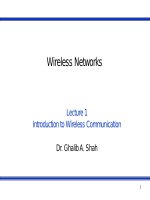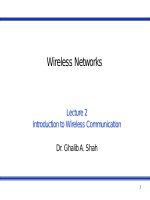Wireless networks - Lecture 15: Analog mobile phone system
Bạn đang xem bản rút gọn của tài liệu. Xem và tải ngay bản đầy đủ của tài liệu tại đây (267.46 KB, 21 trang )
Wireless Networks
Lecture 15
Analog Mobile Phone System
Dr. Ghalib A. Shah
1
outlines
AMPS introduction
System Overview
Call handling
Air interface
Supervisory signals
N-AMPS
2
Last Lecture review
Trunking and Grade of Service
► Measuring Traffic Intensity
► Trunked Systems
• Blocked Calls Cleared
• Blocked Calls Delayed
► Erlang Charts
Improving Coverage and Capacity
►
►
►
►
Cell Splitting
Sectoring
Repeaters for Range Extension
Microcell Zone Concept
3
AMPS Introduction
First deployed in late 1983 in urban and
suburban areas of Chicago.
Total of 40 MHz in 800 MHz band allocated by
FCC
Later on, Additional 10 MHz allocated as user
demand increased
First AMPS systems used large cells and omni
directional antennas to minimize initial
equipment cost
It covered approximately 2100 square miles
4
AMPS system uses 7-cell reuse pattern with provision
of sectoring and cell splitting to increase system
capacity.
After extensive tests, it was found that 30 KHz channel
requires s SIR of 18 dB.
The smallest reuse factor which satisfies this
requirement using 120 degree directional antenna is N
=7
ETACS: European Total Access Communication
System
► Identical to AMPS except scaled to 25 KHz as opposed to 30
KHz
► Different format of mobile identification number (MIN) due to
need of accommodating different country codes
5 in Europe as
opposed to area code in US
AMPS Architecture
6
System Overview
AMPS and ETACS both use FM and FDD for radio
transmission like other 1G systems
In US,
► transmissions from mobiles to BS (reverse link) use
frequencies between 824-849 MHz
► While BS transmits to mobiles (forward link) using frequencies
between 869-894 MHz
► A separation of 45 MHz between forward and reverse channels
is due to use of inexpensive and highly selective duplexers in
mobile units.
The control channel and blank-and-burst data streams
are transmitted at 10kbps in AMPS and 8kbps in
ETACS
These wideband streams have max frequency
deviation of +8KHz and +6.4 KHz for AMPS
and
7
ETACS
Each BS has
► one control channel transmitter that transmits on
forward control channel (FCC)
► One control channel receiver that listen to reverse
control channel (RCC) to set-up a call
► 8 or more duplex voice channels
► Commercial BS supports as many as 57 voice
channels
Forward Voice Channel (FVC) carry the
conversation originating from landline caller to
cellular subscriber
Reverse Control Channel (RVC) in opposite
8
The actual number of control and voice channels varies
widely depending on the traffic, maturity of the system
and location of other BSs.
The number of BS in a service area varies widely as
well from few towers in rural area to several hundred
or more BS in a large city.
Each BS continuously transmits digital FSK data on
FCC at all times so that idle subscriber units can lock
onto the strongest FCC.
All users must be locked onto a FCC in order to
originate or receive calls.
The BS RCC receiver constantly monitors transmission
from subscribers that are locked onto the matching
FCC
9
In US AMPS, there are 21 control channels and
ETACS supports 42 control channels per provider
Thus any cellular phone needs to scan limited number
of control channels to find best serving BS
It is upto the service providers to make sure adjacent
FCC are not assigned to nearby BSs
The nonwireline service provider (“A” provider) is
assigned odd system identification number (SID) and
wireline service provider (“B” provider) is assigned even
SID.
SID is transmitted once every 0.8 seconds on each
FCC, along with other overhead data which reports the
status of cellular system
In ETACS area identification numbers (AID) are used
instead of SID.
10
Call handling
Call: landline user cellular subscriber
► From PSTN arrives at MSC.
► A paging request is sent out with subscriber MIN
simultaneously on every BS FCC.
► If intended subscriber receives its page on FCC, it
responds with ACK on RCC.
► The MSC directs the BS to assign FVC and RVC
pair to take place call
► The BS also assigns supervisory audio tone (SAT)
and a voice mobile attenuation code (VMAC) as it
moves the call to the voice channels
11
► SAT
•
•
it allows user and BS to distinguish each other from co-channel
users located in different cells
Transmitted continuously on the both FVC and RVC at three
different frequencies 5070 Hz, 6000 Hz, 6030 Hz
► VMAC
•
Instructs the user to transmit at a specific power level
► Once on the voice channel, wideband FSK data is used by BS
and subscriber in a blank-and-burst mode to initiate handoffs,
change transmitter power as needed and provide other system
data
► Blank-and-burst signaling allows the MSC to send bursty data
on voice channels by temporarily omitting speech and SAT and
replacing with data.
12
Call: mobile user landline user
► Subscriber transmits request (MIN, electronic serial
number, station class mark and destination number
on RCC
► If received correctly by BS, sent to MSC
► MSC check if user is properly registered, connects to
the PSTN
► Assigns FVC and RVC with SAT and VMAC
13
During a call, MSC issues numerous blankand-burst commands which switch
► Between different voice channels on different BS
depending on where the user is traveling
The MSC uses scanning receiver called locator
in nearby BS to determine RSSI for handoff
14
When a new call request arrives from PSTN or
subscriber
► Voice channels may be occupied
► MSN holds line open while instructing current BS to
issue directed retry to subscriber on FCC
► It forces the subscriber to switch to different control
channel or BS depending on radio propagation
effects, current traffic, location of subscriber
► However it may or may not succeed.
15
AMPS and ETACS air interface
Parameter
AMPS
ETACS
Multiple Access
FDMA
FDMA
Duplexing
FDD
FDD
Channel BW
30 KHz
25 KHz
Traffic channels per RF channel
1
1
Reverse channel freq
824849 MHz
890915 MHz
Forward channel freq
869894 MHz
935960 MHZ
Voice modulation
FM
FM
Data rate on control/wideband channel
10kbps
8kbps
Spectral efficiency
0.33 bps/Hz
0.33 bps/Hz
Number of channels
832
1000
16
Supervisory signals (SAT and ST tones)
Allow each user and BS to confirm that they are
connected during a call
SAT always exists during use of any voice channel.
AMPS and ETACS use three SAT signals at
frequencies of 5970 Hz, 6000 Hz or 6030 Hz
BS constantly transmits one of three SAT tones on
each voice channels when in use
SAT is superimposed on voice signal on both forward
and reverse channels
The particular frequency of SAT denotes location of BS
and is assigned by MSC
17
When a call is setup and a voice channel is
issued
► SAT is transmitted immediately on FVC
► Subscriber unit begins monitoring FVC, it must
detect, filter and demodulate SAT
► Similarly it reproduces SAT on RVC
► This is required to dedicate a voice channel
► If SAT is not presented or improperly detected within
a one second interval, Both BS and subscriber unit
cease transmission
18
Signaling Tone (ST)
► It is a 10 kbps data burst which signals call
termination by the subscriber
► It is a special “end-of-call” message containing
alternating 1s and 0s sent on RVC for 200 ms
► Unlike blank-and-burst messages which briefly
suspends SAT transmission, ST tone must be sent
simultaneously with SAT.
► Alerts the system that user has deliberately
terminated the call as opposed to being dropped by
the system
19
Wideband Blank-and-burst Encoding
AMPS voice channels carry wideband (10
kbps) data streams for blank-and-burst
signaling
The wideband data stream is encoded using
Manchester coding
The advantage is that the energy of the
Manchester coded signal is concentrated at the
transmission rate frequency of 10 KHz and little
energy leaks into audio band below 4 KHz
20
Narrowband AMPS (N-AMPS)
10 KHz channel: 3 times large number of users
and bandwidth
Uses same SAT, ST and blank-and-burst except
signaling was done by using sub-audible data
streams
21









